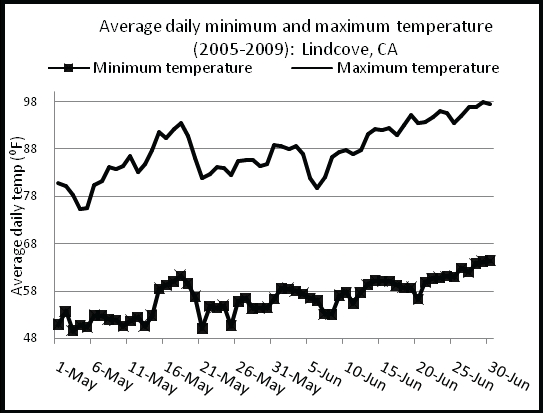The light 2011 olive crop may result in a heavy crop load in 2012. With the prospect of a heavy crop load, it may be wise to consider thinning to reduce fruit quantity and increase fruit size. Management of fruit size may be achieved by pruning and/or chemical thinning.
Why thin your olives?
Larger fruit. Overloaded trees bear small, unprofitable fruit. If a crop is thinned during the fruit’s early growing period, the remaining fruit will grow larger. The larger fruit command a higher price that more than offsets any reduction in total yield. By thinning the crop, you will bring otherwise substandard?sized olives up to canning sizes.
More consistent yearly crops. After a modest crop, shoot growth and prospects for a satisfactory crop the following year are good. In contrast, a heavy crop of olives is followed almost invariably by a light crop.
Early maturity. A moderate crop matures earlier than a heavy crop. An early crop is more likely to get a good reception from the handler, has less competition for harvest labor, is less likely to fall victim to cold weather in the early fall, and ensures a good bloom for the next year.
Lower harvest costs. Olive picking costs are figured on a per-ton basis, so the per-acre harvest costs for a moderate crop are less than for a large crop.
Pruning vs. Chemical Thinning
Pruning removes potential fruit and foliage, stimulating growth which will help minimize alternate bearing. Chemical thinning is achieved with use of the plant growth regulator, naphthaleneacetic acid (NAA). NAA is absorbed into the leaves and fruit and is then translocated to the fruit stems. An abscission layer forms during the first two weeks after NAA application, causing some fruit to drop. Pruning plus chemical thinning is recommended for crop control in Manzanillo; however, chemical thinning is not recommended for Sevillano.
NAA for Olive thinning
NAA Formulation for Olive Thinning. NAA is manufactured in the form of an ammonium salt for commercial use on olive orchards, with 200 g of active ingredient per gallon. This formulation is marketed as Liqui-Stik Concentrate (EPA reg #34704-382) by Platte Chemical Company. The material does not contain wetting agents.
Amount and Timing. The concentration of NAA applied depends on the method used to determine spray timing (full bloom method or fruit size method) and whether a spray oil is used.
Full bloom date method. If you time your spray according to the full bloom date, apply NAA as a dilute spray (300 to 500 gallons per acre 12 to 18 days after full bloom. If applied at 10 days, use a concentration of 100 ppm. Thereafter, increase the concentration by 10 ppm for each day that treatment is delayed. For example, if you spray 15 days after full bloom, use a concentration of 150 ppm. CAUTION: Abnormally cool weather will delay fruit growth. In such a circumstance, use the fruit size method for spray timing.
Fruit size method. If you use the fruit size method, sprays are applied when fruit on the north and south sides of the trees average between 1/8 and 3/16 of an inch. This can be determined by folding a standard 2 x 3-1/2 inch business card in half across the narrow dimension. When 11 to 16 fruit can be placed side by side across the card, it is time to thin. With normal weather, this will usually be between 12 and 18 days after full bloom. It is useful to note the day of full bloom (when approximately 80% of the flowers are open, 10% are unopened and 10% are at petal fall) to allow you to predict spray timing. If you use the fruit size method and spray without a spray oil, apply a concentration of 150 ppm NAA with a wetting agent or spreader-sticker.
Risks and precautions of chemical thinning. The thinning response is dependent on the temperatures shortly following application. Response can vary from no thinning, if temperatures are unusually cool following application, to nearly complete crop removal if temperatures are excessively warm. EPA registration for NAA covers the period from full bloom to 2 1/2 weeks after bloom. Later NAA applications are both illegal and useless. Too early an application will overthin; too late an application will yield unsatisfactory results. An application during bloom will destroy the crop. Hot weather during and following bloom, especially when accompanied by drying winds, can reduce fruit set and make thinning unnecessary. Research has demonstrated that the first two or three days after treatment are the most critical in determining the thinning response. Pay attention to weather forecasts prior to treatment and if forecasted temperatures are significantly warmer or lower than average, (see Figure 1) treatments should be delayed until more normal temperatures return. As the length of time from full bloom increases, the thinning response decreases. NAA should not be used on water stressed trees.
